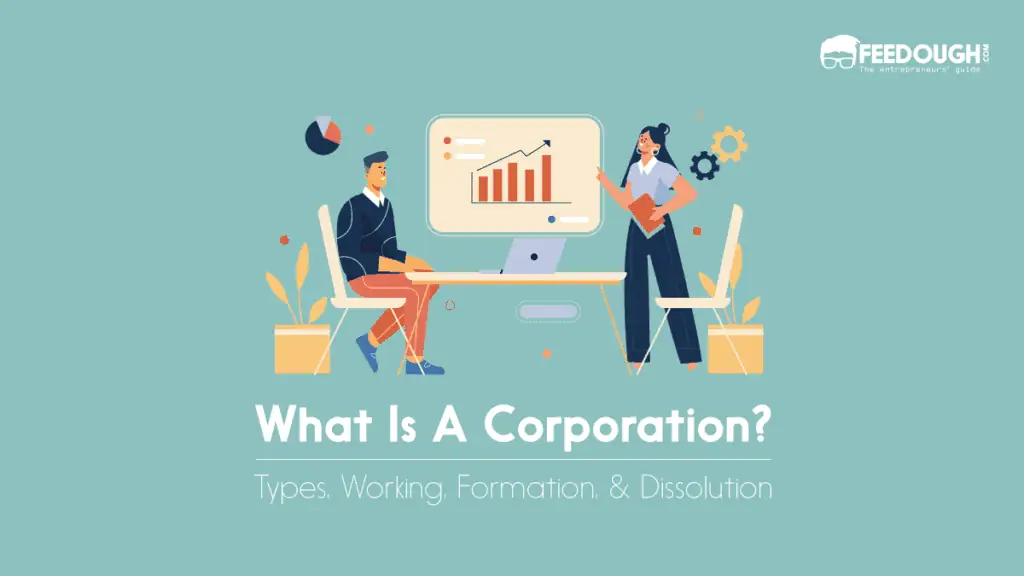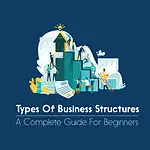On any ordinary day, one may use their Microsoft computer to see their Google emails, take calls on their Apple or Android device, order products from Amazon, and use an Uber to get around. These are all things that are taken for granted.
But what do these brands have in common? They are all examples of corporations that we interact with in our day-to-day lives.
However, what is a corporation exactly? How does it work? How is it formed? And What is its purpose?
Let’s dive in and find answers to these questions.
What Is A Corporation?
A corporation is a legal business entity whose identity is separate from its owners and is formed by shareholders who share a common goal and objective.
The owners or shareholders of the business create it to carry out a specific purpose, such as making money or providing a service.
It is also sometimes referred to as a “legal person” because a corporation can enter into contracts, lend and borrow money, sue and get sued, hire employees, own assets, and pay taxes independently.
How Does A Corporation Work?
A corporation comprises three primary groups: shareholders, the board of directors, and corporate officers.
Shareholders are the people who own the corporation by buying shares in it. They are the ones who elect the board of directors, who in turn, appoint the corporate officers.
The board of directors is a group of people elected by shareholders to oversee the corporation’s management and make sure it is working towards its goals. Their primary responsibilities include setting the corporation’s strategic direction, deciding on major investments, and hiring and firing the CEO.
The corporate officers are the people in charge of running the corporation day-to-day. Their role is to implement the board’s decisions and make sure the corporation runs smoothly. The board of directors appoints them and typically includes the CEO, CFO, and COO.
The 5 Types of Corporations
Corporations aren’t all the same – there are different types that are structured in different ways and offer different benefits. The most common types of corporations are:
C Corporation
A C Corporation is the standard type of corporation that most people are familiar with. It is a for-profit entity that is taxed separately from its owners.
The profits of a C Corporation are subject to corporate income tax, and the shareholders are also taxed on the dividends they receive. This is often referred to as “double taxation.”
C Corporations can have an unlimited number of shareholders and can be publicly traded on stock exchanges.
Some examples of C Corporations include:
- Walmart
- Coca Cola
- IBM
S Corporation
An S Corporation is very similar to a C Corporation, but it is taxed differently. The profits of an S Corporation are only taxed once, at the shareholder level.
This means that the shareholders pay taxes on their personal income tax returns, rather than the corporation itself being taxed.
S Corporations are smaller businesses with 100 or fewer shareholders. They must also be US citizens and can only have one class of stock. Here are other conditions that have to be fulfilled such as;
- There should be no partnerships.
- Non-resident aliens or foreigners cannot be a part of the corporation.
- Cannot have other corporations as shareholders.
- Cannot have more than 100 shareholders.
Some examples of S Corporations include:
- Kraft Heinz
- Hershey
B Corporation
A B Corporation (or “Benefit Corporation”) is a for-profit corporation that is committed to making a positive impact on society, rather than just maximising profits for shareholders.
B Corporations hold themselves to higher standards of social and environmental responsibility. They are also required to report their impact on society, so that shareholders and the public can hold them accountable.
Not all states have laws that recognise B Corporations, but there are currently more than 2,000 B Corporations in over 60 industries across the US.
There are some very rigorous criteria for forming a B corporation, like scoring an 80 or above score on the B Impact assessment, announcing your score to the general public and making a legal commitment to consider the company’s shareholders.
However other aspects are similar to C-corps or S-corps.
Some examples of B Corporations include:
- Patagonia
- Ben & Jerry’s
- New Belgium Brewing Company
Closed Corporations
A Closed Corporation is a corporation that has a limited number of shareholders and isn’t publicly traded.
Closed Corporations are often family businesses or businesses owned by a small group of people. They rarely have over 30 shareholders.
The shareholders of a Closed Corporation have more control over the business than the shareholders of a public corporation. They can also make decisions without holding shareholder meetings.
Some examples of Closed Corporations include:
- Mars Inc.
- Beam Suntory
Non-Profit Corporation
A Non-Profit Corporation is a corporation that doesn’t have shareholders and doesn’t distribute profits to them. In fact, a non-profit corporation can’t make a profit – any surplus income must be reinvested into the organisation.
Non-profit corporations are formed to further a social cause or to provide a public service. They are exempt from paying taxes, but they must follow certain rules and regulations.
Some examples of Non-Profit Corporations include:
- American Red Cross
- The Salvation Army
- Goodwill Industries International
How Is A Corporation Formed?
A corporation is formed by a group of shareholders with the common objective of making profits and protecting themselves from any sort of liability. It is registered as a separate legal entity that can do business, enter into contracts, borrow or lend money, sue or be sued, remit state taxes etc.
However, the process of forming a corporation is complex and lengthy and involves several steps and processes.
The steps of forming a corporation are;
STEP 1- Choose a Business Location
The first step is to choose a location to form the corporation in. The location can play a vital role in the development and growth of the business.
Corporations are usually formed in the place from which the business operates from or it can also be formed in pro-business states that offer special considerations to corporations.
Location of a business can depend on factors like;
- Presence of target market or customer base.
- Various costs, benefits, and regulations stipulated by various government agencies.
- Expenses like property values, rentals, government licenses, and fees, etc.
- Local and state government incentives.
STEP 2- Choose The Business Name
The next step is to choose a name for the corporation. The chosen name should be indicative of the brand identity and match the business offerings. The name should be available and unique.
After choosing the name, it has to be registered to protect and finalise it. Registration can be done in 4 different ways-
- Entity Name: Entity names recognise and protect the business at the state level. This means that the company has to register under the state using a unique legal entity name depending on the business structure and the rules and regulations of the state.
- Trademark: Trademark is a name that protects the business at the national level. Each state has its own trademark infringement laws which are required to be followed.
- Doing business As (DBA) Name: DBA is also known as a trade name, assumed name, or a fictitious name under which a company operates. It has to be registered with the state, county, or city in which your business is located. However, it does not provide any legal protection to the business.
- Domain Name: If a business is incorporated in an online platform then the name of the website has to be registered as the domain name. It helps to protect the online presence of the company.
STEP 3- Appoint Directors
The company’s shareholders appoint the board of directors in the annual general meeting.
These shareholders elect their representatives based on a voting system and quorum, where each shareholder hold a vote equal to their share value.
The number of directors to be appointed will depend on state regulations.
STEP 4- File The Articles of Incorporation
Articles of Incorporation is a formal document required to be filed in the state where the corporation is to be formed. It legally documents the entire process of the creation of a corporation.
It is also referred to as the ‘corporate charter”, “Articles of Association”, or “Certificate of Incorporation”.
It contains pertinent information like;
- The name and physical address of the business.
- A description of the business and its goods and services.
- The name and address of the registered agent, or the person authorised to receive official notices.
- Type of corporate structure
- Names and addresses of the initial board of directors
- Number and type of authorised shares
- Duration of the corporation, if it wasn’t established to exist perpetually
- Name, signature, and address of the incorporator, who is the person in charge of setting up a corporation
STEP 5- Write Corporate Bylaws
The By-laws of a corporation are the rules that govern the functions and management of the corporation. It sets down the rules and regulations of the company and supports any of the rules and laws set down by the government.
Corporate by-laws can include;
- How the corporation will be governed, including the role of directors and officers.
- How meetings are held, voting procedures, electing officers or directors.
- How records will be kept and managed.
- How legal documents will be executed.
- How disputes will be handled.
- How bylaws will be added/amended in the future.
- The date of the annual shareholders’ meeting.
- How to negotiate contracts.
- Who will file annual reports.
- How the corporation will issue stock.
- Fiduciary duties to the corporation (i.e. acting in the best interests of the corporation).
- What constitutes a quorum for voting purposes.
- How the day to day operations of the corporation will be conducted.
By-laws can be amended as required once the corporation has been formed.
The next step is to draft a shareholders’ agreement. A shareholders’ agreement is a document used in the event of the death or retirement of an owner, or some other event that causes an owner to need to transfer ownership of his or her shares in the corporation.
This helps protect the interest of the remaining shareholders and makes the transfer of ownership smoother.
STEP 7- Issue Stock
After the board of directors authorises the issuance of stocks, the next major step is to issue those stocks to the board members and the general public to raise funds for the corporation.
STEP 8- Obtain Business Permits and Licenses
One of the important steps is to obtain the necessary business permits, certificates and licenses from the state and local governments.
These permits and licenses largely depend on the type of industry, the business structure, and the state’s laws in which the company operates.
STEP 9- Register With the IRS and State and Local Tax Agencies
The next step is to register with the Internal Revenue Service(IRS) and other tax agencies like the Securities and Exchange Commission (SEC) and obtain the Federal and State Tax ID number.
STEP 10- Open A Corporate Bank Account
The last step before commencing operations is to create a corporate bank account responsible for all the company’s financial management.
Advantages Of Forming A Corporation
There are several advantages of incorporating a business, such as;
- Creation of a separate legal entity- The main advantage of forming a corporation is the separation of the owners and the business. That means the business or company has a separate legal identity from its owners and can enter into contracts and agreements, sue or be sued, hire employees, pay taxes, etc. independently.
- Limited Personal liability- Shareholders form corporations to protect themselves from any sort of liability. The shareholders are only liable for the number of shares they hold. Any sort of loan borrowed by the company cannot be paid using the owners’ assets.
- Security and perpetuity of business- Corporations are flexible in terms of management and transfer of ownership. Although the particulars of transfer of ownership are given in the by-laws of the corporation, however, if an owner wants to end their ownership, they can directly sell their shares on the market. This helps to increase the stability and continuity of the corporation.
- Access to more capital- Corporations can have multiple owners and publicly sell their ownership. This helps to raise large amounts of funds by selling their stocks and growing the company.
- Competent management- The owners do not directly manage the company. They hire a board of directors to manage the day to day operations of the company and perform other functions of the company. This helps in the company’s more efficient and professional management and helps to make more profits.
- Tax benefits- Some corporations depending on their structure have tax benefits. These tax benefits can be availed based on the distribution of their profits and losses.
Disadvantages Of Forming A Corporation
- Lengthy and complex application process- The application and formation process of corporations can be very complex and lengthy. There are extensive paperwork, documentation and assessments to incorporate a business.
- Rigid formalities, protocols and structure- It is necessary to properly maintain a corporation and follow all the legal requirements and state laws, rules and regulations. Corporations have to adhere to many formalities, by-laws and heavy regulations to maintain corporate status.
- Double Taxation- Double taxation means that the taxes are charged both from the profits of the corporation as well as the from the dividends of the shareholders.
- Expensive- Corporations are expensive to form and operate. It might be easy for established corporations to raise capital by selling shares, but forming and maintaining a corporation can be costly. A lot of startup capital is needed to get a corporation running, in addition to paying the filing charges, ongoing fees and larger taxes.
Dissolving A Corporation
Dissolving a corporation means ending its legal existence. Although the lifespan of a corporate is considered perpetual, it can be ended if there is a change in its charter or if it has fulfilled its purpose.
The process of ending or shutting down a corporation is called “liquidation”. A liquidator facilitates liquidation.
Liquidation can either be a voluntary decision of the shareholders and the board of directors or it could be due to financial collapse or bankruptcy of the company.
The process of liquidation involves various steps that have to be followed to dissolve a corporate. Such steps are;
A board meeting has to be called where the board of directors may propose a plan of dissolution. This must be voted on and passed by the members of the board and the shareholders.
Only a majority vote of approval can initiate the dissolution of the corporation. A majority comprises two-thirds of the shareholders in most states, but this varies from state to state.
This sets out the agreements among directors and shareholders concerning the dissolution process and distribution of assets. The process of liquidation starts once the required permissions are obtained.
STEP 2- Filing Articles Of Dissolution
Also called the certificate of dissolution, the document is filed with the state secretary to inform them that the corporation is to be liquidated. It contains basic information like the name and address of the company, the date of the vote, the number of votes for and against, whether assets have been issued, and the date of execution.
STEP 3- Finalising Taxes And Notify The Internal Revenue Service (IRS) And Other Taxing Authorities
Before the liquidation of the business, all the taxes have to be audited and any unpaid taxes should be paid off to the government.
The IRS has to be notified by filing Form 966, which covers corporate dissolution and liquidation. Then final tax return for the year the business closes has to be filed.
The employer identification number (EIN) and the IRS business account has to be closed by sending a letter to the IRS that contains the business name, address, and EIN, along with the reason for closing the account, i.e., dissolution.
STEP 4- Notifying Creditors And Issuing Notice To Any Claimants For Settling Any Outstanding Debts
All creditors should be notified of the dissolution of the company and the time period they have in which to claim any outstanding debts. This is also a notification to stop any further debts from the creditors.
All the creditors and relevant claimants should be sent a notice in the mail that includes the address to which creditors should send their claims and the information that must be included in the claim.
Any business assets that remain after claims with creditors are settled should be liquidated for distribution to shareholders. This means selling assets, such as business equipment, real estate, and vehicles for cash.
This also includes intangible assets like contracts and intellectual property. All the assets may be liquidated by selling them to appropriate buyers or putting the assets up for auction or holding a discount sale, etc.
STEP 6- Wrap Up Operations And Close Accounts And Credit Lines, Cancel Licenses, Etc.
The last step is to wrap up any remaining business affairs that could include closing accounts, cancelling credit lines and licences, etc. At this point, no other business activities can be conducted other than winding down the business.
This includes;
- Fulfilling any remaining contractual obligations
- Ending contracts with clients
- Collecting any outstanding debts taking care of any commitments to employees
- Notifying vendors and customers that the business will be closed,
- Terminating any permits or licenses
- Withdrawing from leases on business properties
- Lastly ensuring that the financial records are properly maintained and balanced so that the corporate bank accounts and service accounts can be closed.
This can be done by issuing a formal notice in a local newspaper, magazine, or journal.
Go On, Tell Us What You Think!
Did we miss something? Come on! Tell us what you think about our article on what is a corporation in the comments section.
A lawyer dealing with corporate laws, a voracious reader and a keen writer. Satyaroop has a broad experience in the legal and startup industries and has worked with more than 15 companies, startups and legal publications on research-oriented projects. In his spare time, he enjoys reading fiction, biking and playing video games.









